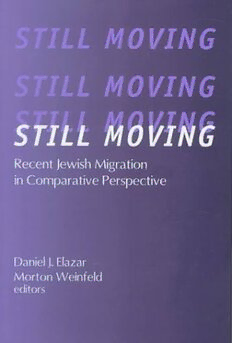
Still moving: recent Jewish migration in comparative perspective PDF
02000·0.869 MB·English
Most books are stored in the elastic cloud where traffic is expensive. For this reason, we have a limit on daily download.
Preview Still moving: recent Jewish migration in comparative perspective
Description:
The aftermath of World War II was a period of massive Jewish migration. Nearly two million Jews came to settle in the new state of Israel; hundreds of thousands moved to North America, Australia, and France, while tens of thousands resettled elsewhere in Europe and the world. Emigration was, in turn, paralled by large-scale movement among second-generation Jews from the great urban centers to the suburbs. Until recently, it has seemed as though the Jewish people had, in the words of the Bible, reached a situation of rest and landed inheritance. However, fifty years later Jews are still moving: from the former Soviet Union, to and from Israel, and within nations where they have been long resident. Still Moving examines the causes and character of contemporary migration in Israel and throughout the Diaspora. The contributors to this volume adopt a cross-cultural comparative approach. Part 1 establishes the context of the new migration globally with emphasis on its effects on Israeli democracy. Part 2 surveys immigration to Israel in the 1990s with particular emphasis on Russian emigres and internal migration from rural to urban centers. Migration to the Diaspora is covered in part 3. Part 4 focuses on the changing nature of the Diaspora and its relations with Israel. Beyond its grounding in Jewish culture and history, Still Moving frames questions that are central to understanding contemporary migration in general: Does immigration accelerate or retard the abilities of host countries to restructure economically? How does greater ethnic diversity affect the social and cultural life of cities? What factors help immigrants integrate into the wider community? Does immigration contribute to the creation of a marginalized underclass? Still Moving will be essential reading for historians, sociologists, Jewish studies specialists, and policy analysts.
See more
The list of books you might like
Most books are stored in the elastic cloud where traffic is expensive. For this reason, we have a limit on daily download.
